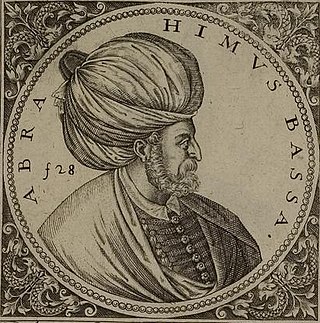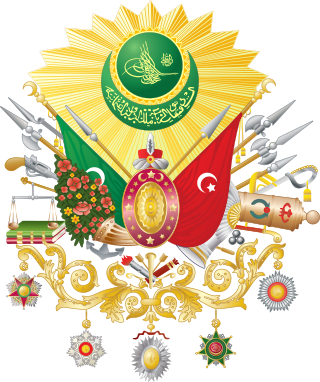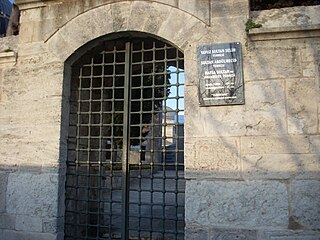Related Research Articles

Bayezid II was the sultan of the Ottoman Empire from 1481 to 1512. During his reign, Bayezid consolidated the Ottoman Empire, thwarted a pro-Safavid rebellion and finally abdicated his throne to his son, Selim I. Bayezid evacuated Sephardi Jews from Spain following the fall of the Nasrid Kingdom of Granada and the proclamation of the Alhambra Decree and resettled them throughout Ottoman lands, especially in Salonica.

Şehzade Mustafa was an Ottoman prince, son of sultan Suleiman the Magnificent and his concubine Mahidevran Hatun. He was the governor of Manisa from 1533 to 1541, of Amasya from 1541 to 1553, when he was executed by his father's order.

Ibrahim was the sultan of the Ottoman Empire from 1640 until 1648. He was born in Constantinople, the son of sultan Ahmed I by Kösem Sultan, an ethnic Greek originally named Anastasia.
Ibrahim Pasha may refer to the following Ottoman statesmen:

Pargalı Ibrahim Pasha, also known as Frenk Ibrahim Pasha, Makbul Ibrahim Pasha, which later changed to Maktul Ibrahim Pasha after his execution in the Topkapı Palace, was the first Grand Vizier of the Ottoman Empire appointed by Sultan Suleiman the Magnificent.
Damat Ibrahim Pasha was an Ottoman military commander and statesman who held the office of grand vizier three times (the first time from 4 April to 27 October 1596; the second time from 5 December 1596 to 3 November 1597; and for the third and last time, from 6 January 1599 to 10 July 1601. He is known as the conqueror of Kanije.

Lala Mustafa Pasha, also known by the additional epithet Kara, was an Ottoman Bosnian general and Grand Vizier from the Sanjak of Bosnia.

The following outline is provided as an overview of and topical guide to the Ottoman Empire:
Dukaginzade Ahmed Pasha, born Progon Dukagjini, was a high-ranking statesman and military commander of the Ottoman Empire in the early 16th century. He hailed from the Albanian Dukagjini family, one of the strongest in pre-Ottoman medieval Albania.

Yunus Pasha was an Ottoman statesman. He was Grand Vizier of the Ottoman Empire for eight months in 1517, serving from January 30 until his death on September 13.

Piri Mehmed Pasha was an Ottoman statesman, and grand vizier of the Ottoman Empire from 1518 to 1523.

Lütfi Pasha was an Ottoman Albanian statesman, general, and Grand Vizier of the Ottoman Empire under Suleiman the Magnificent from 1539 to 1541. He wrote 21 works mainly on religious topics but also on history, 13 of them written in Arabic and eight in Turkish. Two of his works are the Asafname, a kind of mirror for ministers, and the Tevâriḫ-i Âl-i ‘Os̱mân, dealing with Ottoman history and including his own experiences in the reign of the sultans Bayezid II, Selim I and Suleyman I.

Melek Ahmed Pasha was an Ottoman statesman and grand vizier during the reign of Mehmed IV.

Şehzade Bayezid was an Ottoman prince as the son of Sultan Suleiman the Magnificent and Hürrem Sultan.

Şehzade Mehmed was an Ottoman prince, son of Sultan Suleiman the Magnificent and his wife Hürrem Sultan. He served as governor of Manisa.

Hatice Sultan was an Ottoman princess, daughter of Sultan Selim I and Hafsa Sultan. She was the sister of Sultan Suleiman the Magnificent.

Çoban Mustafa Pasha was an Ottoman statesman. Likely born in Bosnia-Herzegovina or Serbian Sandzak, and collected through Devshirme to Janissaries, where he gradually rose through the ranks, he eventually served as kapıcıbaşı, vizier, and beylerbey for the Ottoman Empire during various parts of his life.
Hümaşah Sultan, also known as Hüma Sultan, was an Ottoman princess, the daughter of Şehzade Mehmed (1521–1543) and the granddaughter of Sultan Suleiman the Magnificent of the Ottoman Empire, and his favourite consort and legal wife Hurrem Sultan.

Selim I, known as Selim the Grim or Selim the Resolute, was the sultan of the Ottoman Empire from 1512 to 1520. Despite lasting only eight years, his reign is notable for the enormous expansion of the Empire, particularly his conquest between 1516 and 1517 of the entire Mamluk Sultanate of Egypt, which included all of the Levant, Hejaz, Tihamah and Egypt itself. On the eve of his death in 1520, the Ottoman Empire spanned about 3.4 million km2 (1.3 million sq mi), having grown by seventy percent during Selim's reign.
References
- 1 2 Yayın Kurulu "Ahmet Paşa (Hain)", (1999), Yaşamları ve Yapıtlarıyla Osmanlılar Ansiklopedisi, İstanbul:Yapı Kredi Kültür Sanat Yayıncılık A.Ş. volume 2, p.146 ISBN 975-08-0072-9
- 1 2 3 Süreyya, Bey Mehmet, Nuri Akbayar, and Seyit Ali. Kahraman. Sicill-i Osmanî. Beşiktaş, İstanbul: Kültür Bakanlığı Ile Türkiye Ekonomik Ve Toplumsal Tarih Vakfı'nın Ortak Yayınıdır, 1890. Print.
- 1 2 Holt, P. M.; Gray, Richard (1975). Fage, J.D.; Oliver, Roland (eds.). "Egypt, the Funj and Darfur". The Cambridge History of Africa. IV. London, New York, Melbourne: Cambridge University Press: 14–57. doi:10.1017/CHOL9780521204132.003. ISBN 9781139054584.
- ↑ Kaya Şahin (29 March 2013). Empire and Power in the Reign of Süleyman: Narrating the Sixteenth-Century Ottoman World. Cambridge University Press. p. 54. ISBN 978-1-107-03442-6.
- ↑ Raymond, André (2001). Cairo: City of History. Translated by Willard Wood (Harvard ed.). Cairo, Egypt; New York, New York: American University in Cairo Press. p. 191. ISBN 978-977-424-660-9.
- ↑ Şahin, Kaya (2013). "The Secretary's Progress (1523-1534): An Ottoman Grand Vizier in Action: The Egyptian Inspection". Empire and Power in the Reign of Süleyman: Narrating the Sixteenth-Century Ottoman World. Cambridge Studies in Islamic Civilization (reprint ed.). Cambridge: Cambridge University Press. pp. 55–56. ISBN 9781107034426 . Retrieved 3 February 2020.
[İbrahim Pasha] reached Cairo on April 2 [1525]. He immediately set out to secure control of the province through a mixture of violence and charity. [...] However, İbrahim wanted to leave a larger impact on Egypt, and his next step was to lay down the grounds for a viable ottoman administration.
- ↑ Gökbilgin, M. Tayyib (1952). XV-XVI. asırlarda Edirne ve Paşa Livası: vakıflar, mulkler, mukataalar . Üçler Basımevi. p. 380.